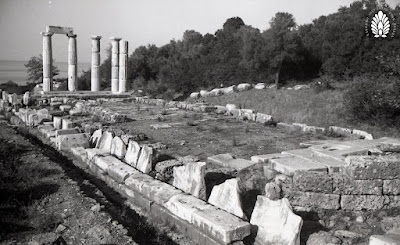
This year’s season was the second of our two planned study seasons,
and so we returned to our usual summer digs in Myloi with a small team
of faculty and graduate students. Our main priority was the study of the
tens of thousands of artifacts that we collected in the field, housed
in our αποθήκη (storage facility) in Argos. Sarah James and Scott
Gallimore, the other directors of our project, organized a team composed
of themselves, Grace Erny, Joseph Frankl, Alyssa Friedman, Melanie
Godsey, Machal Gradoz, and Ginny Miglierina, joined by a number of
visiting scholars: Daniel Pullen, for his expertise in prehistoric
pottery, Guy Sanders, for Medieval and post-Medieval pottery, and Kim
Shelton, for Mycenaean pottery. We were also joined by Christina Kolb,
who illustrated pottery, and Susan Caraher, who helped us with artifact
photography. [Figure 1: In the foreground Melanie Godsey (left) and
Machal Gradoz (right) sort pottery; Alyssa Friedman, Scott Gallimore,
and Guy Sanders work in the background.]
The αποθήκη team focused on reexamining artifacts from areas of
interest, refining our identification of materials of all periods, and
cataloguing artifacts of various types and from different parts of our
survey area. In the previous year, we had focused on material
associated with 14 areas that we had preliminarily identified as “sites”
– which we used not as a technical term, but rather as a kind of
shorthand for large clusters of dense units – and pulled representative
artifacts from each of them for cataloguing. This work continued in
2018, with a focus on two types of material: first, those that we hadn’t
examined from the previous year, and second, objects that we initially
assigned to the broadest chronological categories. There were big
changes to our understanding, thanks especially to our visiting
scholars, who helped us to refine our identifications of material from
the Late Bronze, Medieval, and Ottoman periods.
The other main goal of the study season had to do with our data.
Here, Bill Caraher, Rachel Fernandez, and I were the main participants,
assisted by the other members of the project. Some of our work involved
going out into our survey area to revisit areas of interest and to
ensure that our documentation was sufficiently rich for our preliminary
and final publications. [Figure 2: Rachel Fernandez (center) and Bill Caraher (left) at Palaiokastraki.]

We mainly worked on our digital data, however, in part to help guide the
team working in our storage facility and in part to advance our
analysis of the survey as a whole. Bill and Rachel prepared our survey
data for publication, and worked on ways to analyze and visualize
artifacts of the same (or similar) date that cluster in the landscape.
We found, for instance, that 50 meter buffers around each unit with
material of a particular date allowed us to identify clusters that could
act as starting points for more detailed analyses. [Figure 3: Clusters of Archaic material (in blue) in the western part of our survey area.]

We also continued to work on the modern period. Ioanna Antoniadou
returned to continue her invaluable ethnographic work, conducting
interviews and consulting local archives. Kostis Kourelis visited us for
a couple of days, helped us to interpret some recently-abandoned modern
houses in our survey area, and consulted on how to document the modern
villages on the edges of our survey.
[Figure 4: Kostis Kourelis illustrates an abandoned 20th century house at Chelmis.]
All in all, it was an amazingly productive summer. We effectively
finished analyzing the artifacts from the survey, thanks to a lot of
hard work by a large and dedicated team, and readied our field data for
publication. Closely working with this evidence has made us question
many of our past narratives for the region, and encouraged us to come up
with better interpretations for what we are finding. Yet for all of the
incredible work that we did this summer, so much more remains to be
done (hence the title of this post). In this coming winter, we’ll need
to continue to work closely with our digital data and, most importantly,
begin to write our contributions for the project’s publication.
Fortunately all of this year’s efforts will give us a very solid
foundation to build on!
Dimitri Nakassis
Professor, University of Colorado Boulder; co-director, Western Argolid Regional Project

























